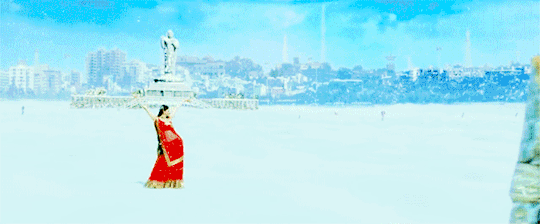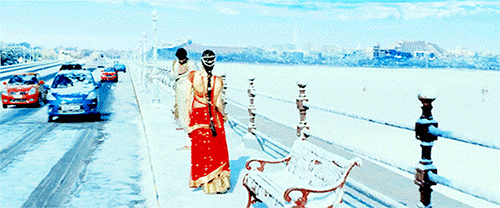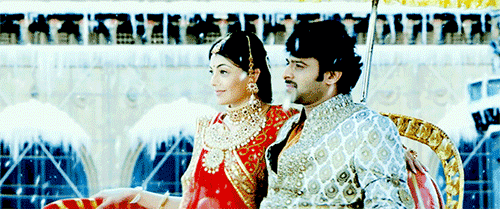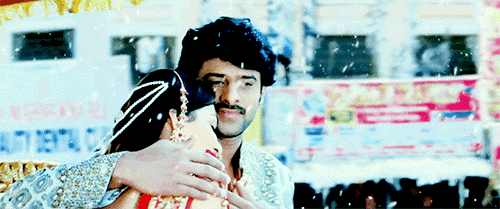#I love both versions (telegu + tamil)
Photo








#FETUS PRABHAS AND KAJAL OMG#MY HEART#I love this movie too much#it was dubbed into tamil but the acting of the dubbers were GREAT#I love both versions (telegu + tamil)#kajal aggarwal#prabhas#kajalgif#prabhasgif#darlinggif#darling#kollywood#tollywood#tamil#telegu#south indian actor#south indian actress#tamil actor#tamil actress#indian actor#indian actress#kajal aggarwal gif#prabhas gif
36 notes
·
View notes
Photo

Although it rained the night before, it’s done little to cool the air. Even at 9am, the sun is already blazing down. The thermometer shows 39 degrees Celsius and is poised to climb further. It’s Easter, so the schools are closed, and there’s a snaking queue at the ticket counter of Ramoji Film City (RFC), on the southeastern edge of Hyderabad, in the Indian state of Telangana.
The set of popular Telugu mythological TV series Sri Bhagavatam
Sprawled across 810 hectares, RFC features in the Guinness Book of World Records as the largest film studio complex in the world, specialising in Telugu-language cinema. It’s widely visited by movie buffs from Andhra Pradesh and Telangana, the two southern Indian states that share Telugu as their main language. If that sounds niche, Telugu is in fact one of the 22 major languages in India, ranked third in the country by number of native speakers. Moreover, according to US-based publication Ethnologue, it’s also the 12th-most spoken language in the world, with 82 million speakers.
Introducing Tollywood
It makes sense then that, as well as being a working film studios, RFC is one of the most popular tourist attractions in India, welcoming around 1.5 million domestic and international tourists each year. On any average day, the studios see a footfall of 2,500 visitors. During last year’s summer holidays, it topped 16,000 in a single day. The crowds come for a chance to wander through the sets of their favourite films and shows, with secret hopes of catching famous actors at work.
Models of trains and vintage cars from the props department
Also known as Tollywood, this strand of Indian cinema dedicated to producing movies in Telugu may not be as well-known internationally as Bollywood, but a handful of its past deliveries have seen it go toe-to-toe with its Mumbai-based cousin, in terms of budgets and box office numbers. A recent example is 2017’s Baahubali 2: The Conclusion, the second of two period films that follow a young villager who discovers his royal heritage and saves his fictional kingdom in medieval India.
“Entertainment is the only mantra in Telugu films; they spend lavishly on costumes, sets, special effects, action scenes and musical scores”
This lavish production, shot entirely at RFC, cost INR2.5 billion (S$49 million) to shoot and went on to capture worldwide attention. A dubbed version was the highest-grossing Hindi movie of all time. Also made available in Tamil, Malayalam, Japanese, Russian and Chinese, the film grossed INR18.1 billion (S$353 million) at the box office worldwide. Buoyed by its success, there have been a series of even more ambitious Telugu productions in the works, including one titled RRR, from Baahubali director SS Rajamouli. Another action movie, this time set in pre-Independence India, the film will cost INR4 billion (S$78 million) and is set for release next year. Sci-fi action thriller Saaho, featuring Baahubali star Prabhas, is coming to cinemas on 15 August this year and cost more than INR3 billion (S$58.5 million) to make. Needless to say, both films were shot at RFC.
Remnants of the Baahubali set
A cinematic visit
Beyond the ticket counter and after a brief security check, I join the visitors to get into a bright red, vintage-style, hop-on-hop-off coach that will take us around the complex. Each coach seats about 25 visitors and includes a guide who points out the different landmarks where iconic scenes of popular films were shot.
Our coach makes its first stop at Eureka, a huge courtyard that acts as the entry area into five major attractions. Designed to mimic with white marbled floors, lavish staircases and landscaped gardens, the threshold to this cinematic town hints at what lies ahead.
Princess Street is one of the many urban city sets in RFC
Despite Telugu cinema’s long history dating back to its first silent feature film in 1921, it was only in the early 1990s that the Telugu Film Industry (TFI) completely shifted base to Hyderabad, as major Telugu producers started setting up their own sets and studios in the state capital. RFC was founded in 1996 by film mogul and producer Cherukuri Ramoji Rao.
Recognising the need for an infrastructure of pre-designed sets and ambience, Rao shaped RFC while at the peak of his career “to provide comprehensive filmmaking facilities under one roof,” explains RFC vice president AV Rao. “The tourism potential was only realised in later years when people expressed a desire to have a glimpse of where their favourite films were made.”
Entrance to the five live shows in RFC
According to Rao, over 2,600 films in various languages have been shot at RFC so far. There are around 50 shooting floors, the largest being the size of two football fields. RFC also has dedicated departments for set construction, props, craft services and camera and lighting rental.
Back at Eureka, I find shade under a flowering bougainvillea, as traditional Rajasthani music floods the open compound and early visitors fill in. At 9.45am, the music switches to a more energetic number as two wooden plank-doors leading to the Central Court start to ancient Indian forts and palaces, complete swing open and a group of dancers dressed in golden costumes and ornate jewellery appear to draw in the mass of visitors.
A hop-on-hop-off coach takes you around the film city
“Which way is Fundustan?” A hassled parent with two young children in tow breaks the calm that descends after the music stops. Our guide, a burly man in his forties, directs them towards the themed children’s play area, where thrilling rides and fascinating games await. Adjacent to it is Borasura, a spine-chilling walk-through designed as a magician’s workshop.
Globalising entertainment
Largely devoted to mainstream filmmaking with a wide commercial appeal, Tollywood has in recent years shed its regional character, delivering colossal productions that are dubbed in multiple languages worldwide. “Entertainment is the only mantra in Telugu films. They spend lavishly on costumes, sets, special effects, action scenes and musical scores,” enthuses Himavati Kurup, a college student from Coimbatore and my fellow passenger in the RFC coach. “And we love watching them.”
Setting up a scene at a pre-designed railway station set
Another college student and amateur filmmaker Venu Nagaraju, who is also on the tour makes another interesting observation. “In most Telugu films, you will see a surprising storyline,” he says. “We, the Telugu people, love fantasy and horror and will lap up any film that gives us these. And if the story is not strong enough to hold your attention, the costumes and sets will definitely do it.”
As we chat, our coach passes by a replica of the Hawa Mahal, the pink palace in Jaipur, a doorway of Fatehpur Sikri – the Mughal city just outside Agra – before driving past rolling, landscaped fields. My fellow passengers raise a cheer whenever our guide names the popular Bollywood and Tollywood films – such as Dilwale (2015) or Mirchi (2013) – that were shot at the locations we pass.
A visitor walks past part of the Baahubali set
The coach pulls to a stop near North City, where permanent sets resemble a suburban neighbourhood in a north Indian town, with multi-storied buildings featuring adorned columns, arched doorways, winding corridors and wooden carvings. A film is being shot inside one of the palatial houses and some of us try to sneak in, only to be pulled back by our guide.
“When a location is rented out for a movie, the producers take over and arrange for props to further dress up the scene. The area then belongs to the producer and we are not supposed to trespass,” he explains.
Guests enjoying a Rajasthani dance performance
As such, visitors are unlikely to witness a film being shot. However, some guests do get lucky and chance upon film stars. R Lakshmana Rao, a Hyderabad businessman on his third RFC visit, shares how he met Bollywood superstar Salman Khan here two years ago. “He was awesome and very humble, and took pictures with us.”
Just down the street are façades of rural village homes that can be found in South India, and around a corner, a street dressed up to look like a generic urban thoroughfare in Europe or the US. Our guide quips: “This is the only place in the world where you can travel from a North Indian city to a South Indian city by crossing a street, and to Europe or America without a passport.”
At these permanent railway sets, the hoardings, letterings and billboards can easily be changed to match the film
The bus halts next at the indoor sets of Sri Bhagavatam, a popular mythological Telugu television series from 2013, based on the life and deeds of Lord Krishna. Diagonally opposite this fantastical set is the façade of a tiny airport, with a huge parking lot. Our guide reveals that the fight scenes from the 2015 Shah Rukh Khan romantic action film Dilwale was shot here.
“This is the only place in the world where you can travel from a North Indian city to a South Indian city by crossing a street, and to Europe or America without a passport.”
“I am here to see the sets of Baahubali,” 75-year-old Manorama Nair from Kochi tells me, pausing for breath as she braves the noon sun while her granddaughters run up the staircases to reach the famous throne. “Baahubali was a great entertainer, and I am curious to know how they made the film. I have read almost every article written about the movie.”
The massive wooden entrance that leads to Central Court
It’s almost past 1pm and I am ravenous. Over the buffet spread at Superstar, one of the most luxurious restaurants in RFC, I reflect on the meaning Telegu cinema holds for its fans. Telugu viewers hold their films and their film personalities in high regard. I think back to the words of Anna Kowalski, a young Polish tourist I met on the coach earlier today. She and her partner were struck by their fellow riders. “We will take back with us the exuberance and craziness of the people here, and how they relate to films as well as they relate to life.”
Indeed cinema here is not just entertainment; it’s a way of life. It’s the high emotion, the grandness of life as it appears in Telugu cinema that pulls people into its fold – and why a visit to RFC is such a draw.
SEE ALSO: Taste of summer: India’s love for mangoes
This article was originally published in the June 2019 issue of Silkwinds magazine
The post On set in Hyderabad at the largest film studio in the world appeared first on SilverKris.
1 note
·
View note